Report: Implementing Planned Change at SAR Health Services (RKC)
VerifiedAdded on 2022/09/18
|16
|4140
|28
Report
AI Summary
This management report, prepared for SAR Health Services (SARHS), addresses the implementation of planned change within the organization. It begins by identifying key factors the management team must consider, such as market conditions, technological advancements, stakeholder needs, and the impact on daily operations. The report then delves into people management issues, including employee awareness, conflict resolution, morale, and the impact on training and organizational culture. Drawing on theories like Kotter's change management theory, sustainable development, and behavioral management, the report offers recommendations, emphasizing the role of mid-level managers, regular board meetings, and clear communication. The report also highlights the importance of leadership, clear objectives, and effective communication to navigate the challenges of change management, and to make sure the change is successful. The report is a complete analysis of the organization's change management procedures.
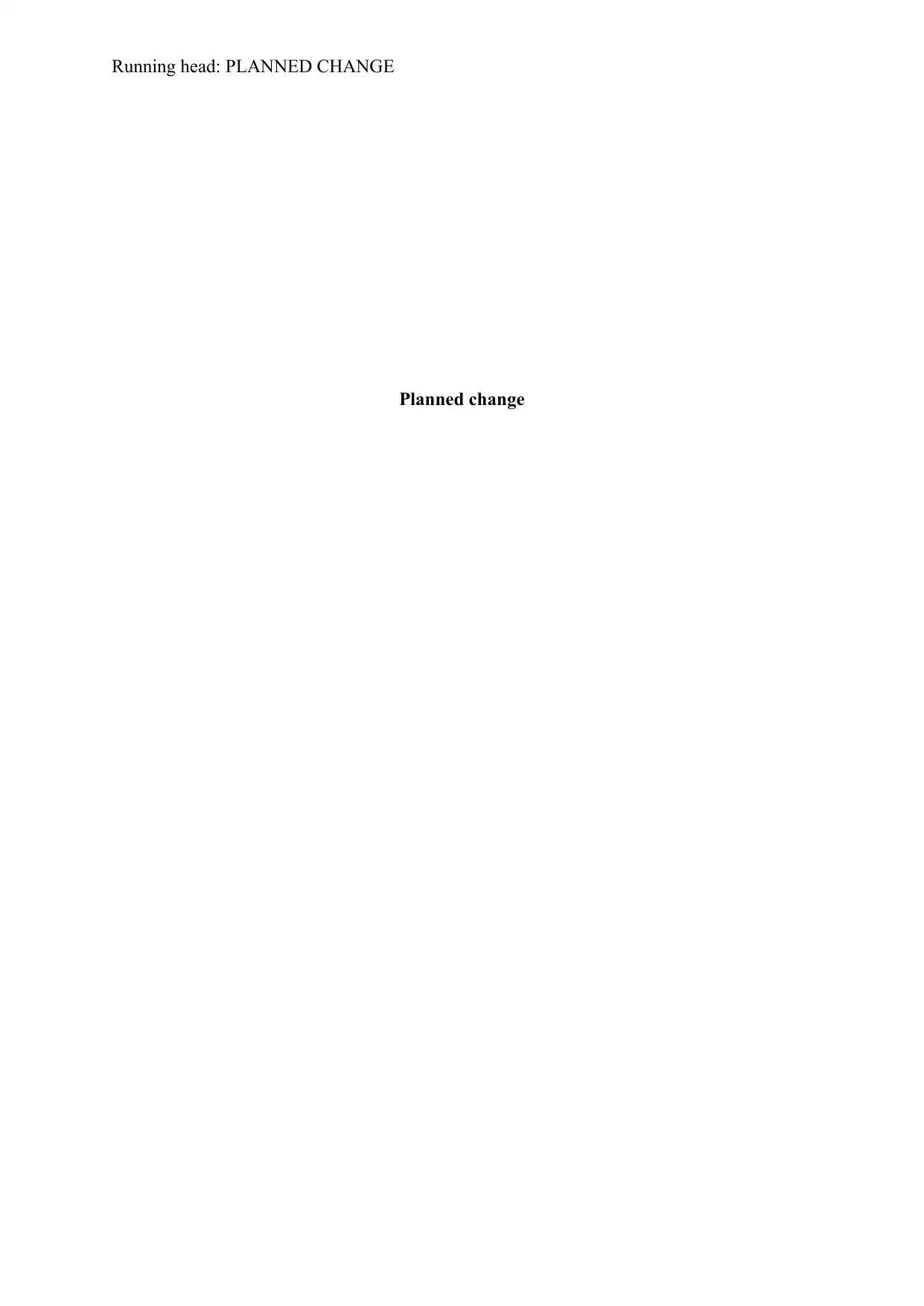
Running head: PLANNED CHANGE
Planned change
Planned change
Paraphrase This Document
Need a fresh take? Get an instant paraphrase of this document with our AI Paraphraser
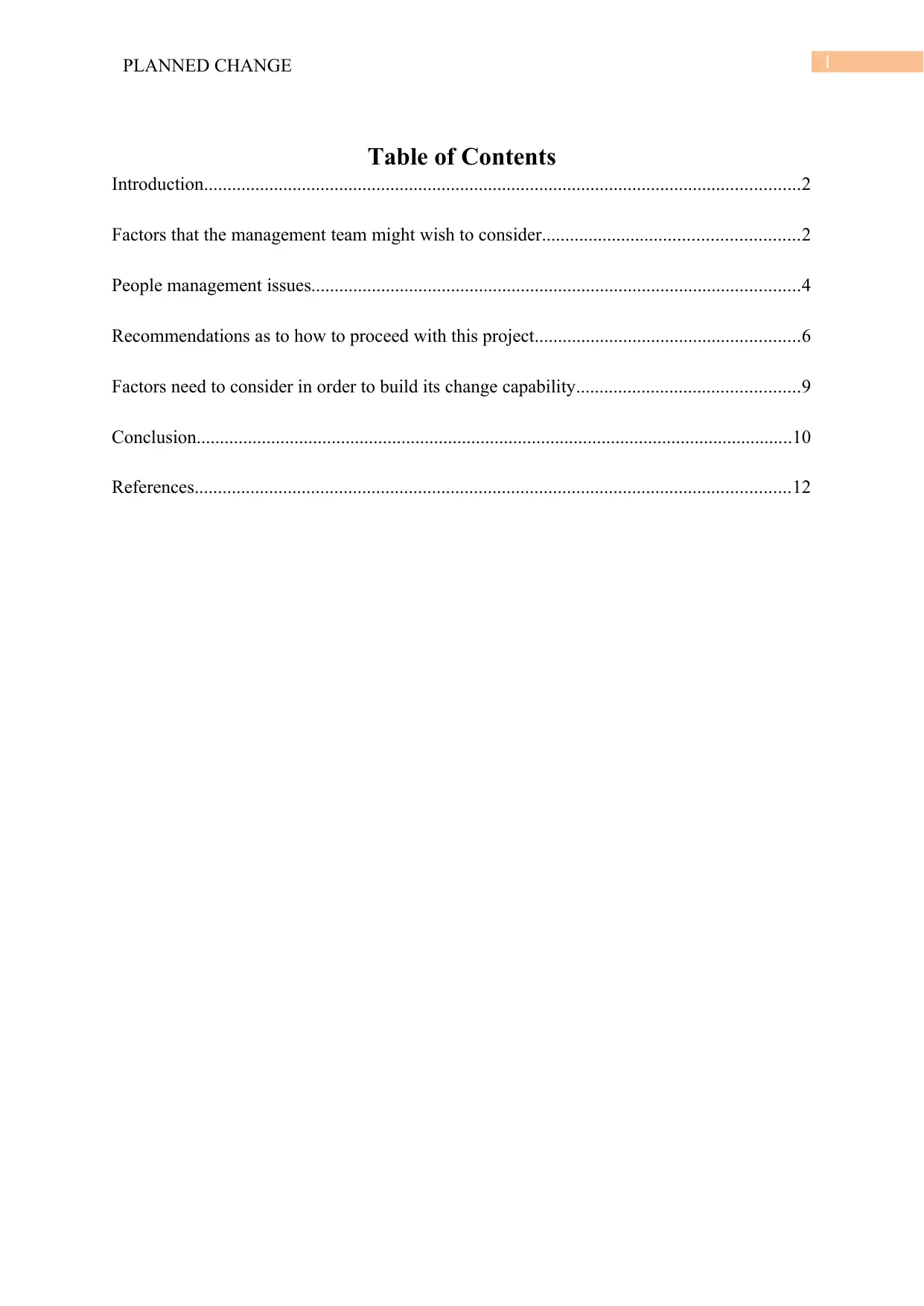
1PLANNED CHANGE
Table of Contents
Introduction................................................................................................................................2
Factors that the management team might wish to consider.......................................................2
People management issues.........................................................................................................4
Recommendations as to how to proceed with this project.........................................................6
Factors need to consider in order to build its change capability................................................9
Conclusion................................................................................................................................10
References................................................................................................................................12
Table of Contents
Introduction................................................................................................................................2
Factors that the management team might wish to consider.......................................................2
People management issues.........................................................................................................4
Recommendations as to how to proceed with this project.........................................................6
Factors need to consider in order to build its change capability................................................9
Conclusion................................................................................................................................10
References................................................................................................................................12
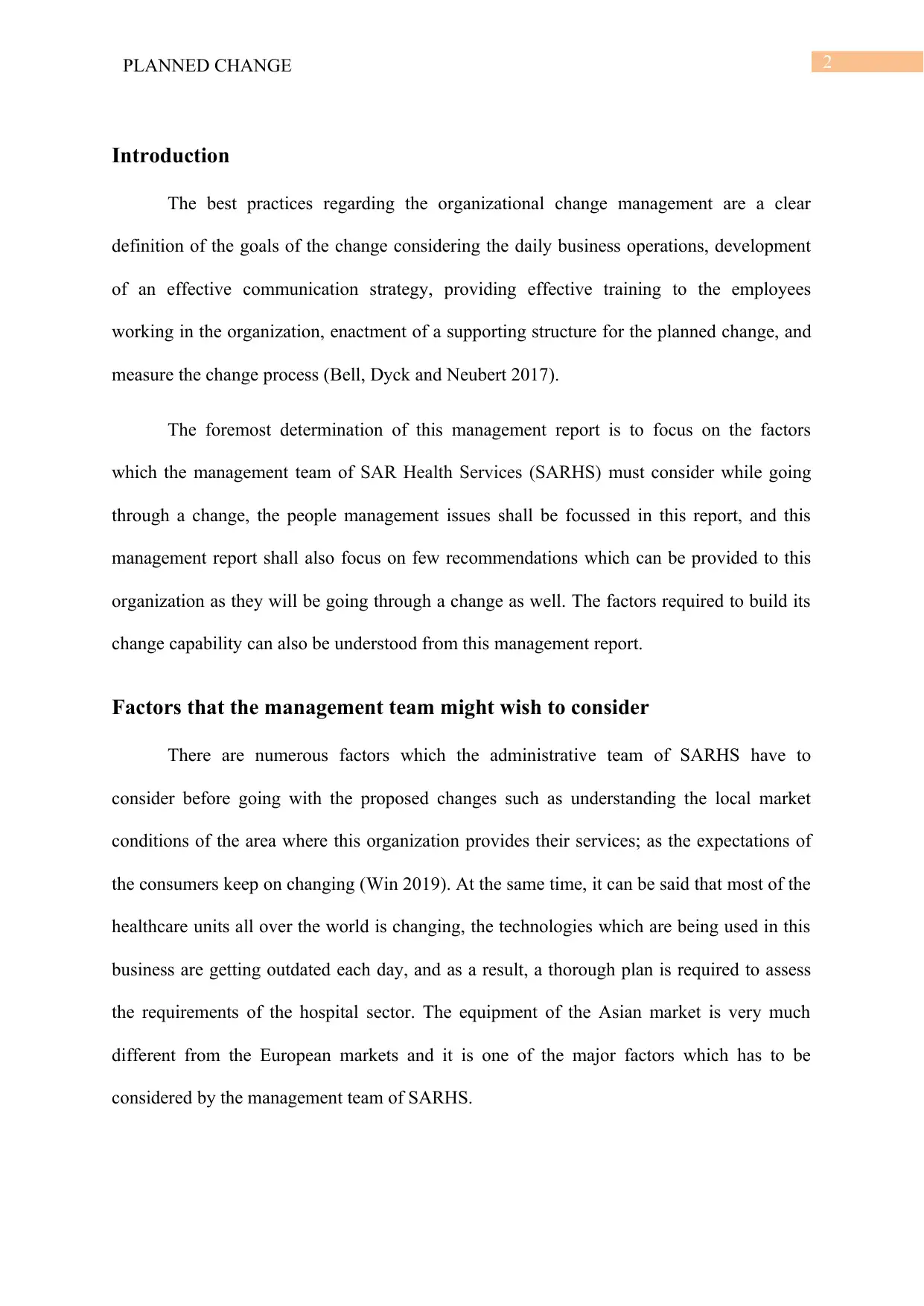
2PLANNED CHANGE
Introduction
The best practices regarding the organizational change management are a clear
definition of the goals of the change considering the daily business operations, development
of an effective communication strategy, providing effective training to the employees
working in the organization, enactment of a supporting structure for the planned change, and
measure the change process (Bell, Dyck and Neubert 2017).
The foremost determination of this management report is to focus on the factors
which the management team of SAR Health Services (SARHS) must consider while going
through a change, the people management issues shall be focussed in this report, and this
management report shall also focus on few recommendations which can be provided to this
organization as they will be going through a change as well. The factors required to build its
change capability can also be understood from this management report.
Factors that the management team might wish to consider
There are numerous factors which the administrative team of SARHS have to
consider before going with the proposed changes such as understanding the local market
conditions of the area where this organization provides their services; as the expectations of
the consumers keep on changing (Win 2019). At the same time, it can be said that most of the
healthcare units all over the world is changing, the technologies which are being used in this
business are getting outdated each day, and as a result, a thorough plan is required to assess
the requirements of the hospital sector. The equipment of the Asian market is very much
different from the European markets and it is one of the major factors which has to be
considered by the management team of SARHS.
Introduction
The best practices regarding the organizational change management are a clear
definition of the goals of the change considering the daily business operations, development
of an effective communication strategy, providing effective training to the employees
working in the organization, enactment of a supporting structure for the planned change, and
measure the change process (Bell, Dyck and Neubert 2017).
The foremost determination of this management report is to focus on the factors
which the management team of SAR Health Services (SARHS) must consider while going
through a change, the people management issues shall be focussed in this report, and this
management report shall also focus on few recommendations which can be provided to this
organization as they will be going through a change as well. The factors required to build its
change capability can also be understood from this management report.
Factors that the management team might wish to consider
There are numerous factors which the administrative team of SARHS have to
consider before going with the proposed changes such as understanding the local market
conditions of the area where this organization provides their services; as the expectations of
the consumers keep on changing (Win 2019). At the same time, it can be said that most of the
healthcare units all over the world is changing, the technologies which are being used in this
business are getting outdated each day, and as a result, a thorough plan is required to assess
the requirements of the hospital sector. The equipment of the Asian market is very much
different from the European markets and it is one of the major factors which has to be
considered by the management team of SARHS.
⊘ This is a preview!⊘
Do you want full access?
Subscribe today to unlock all pages.

Trusted by 1+ million students worldwide
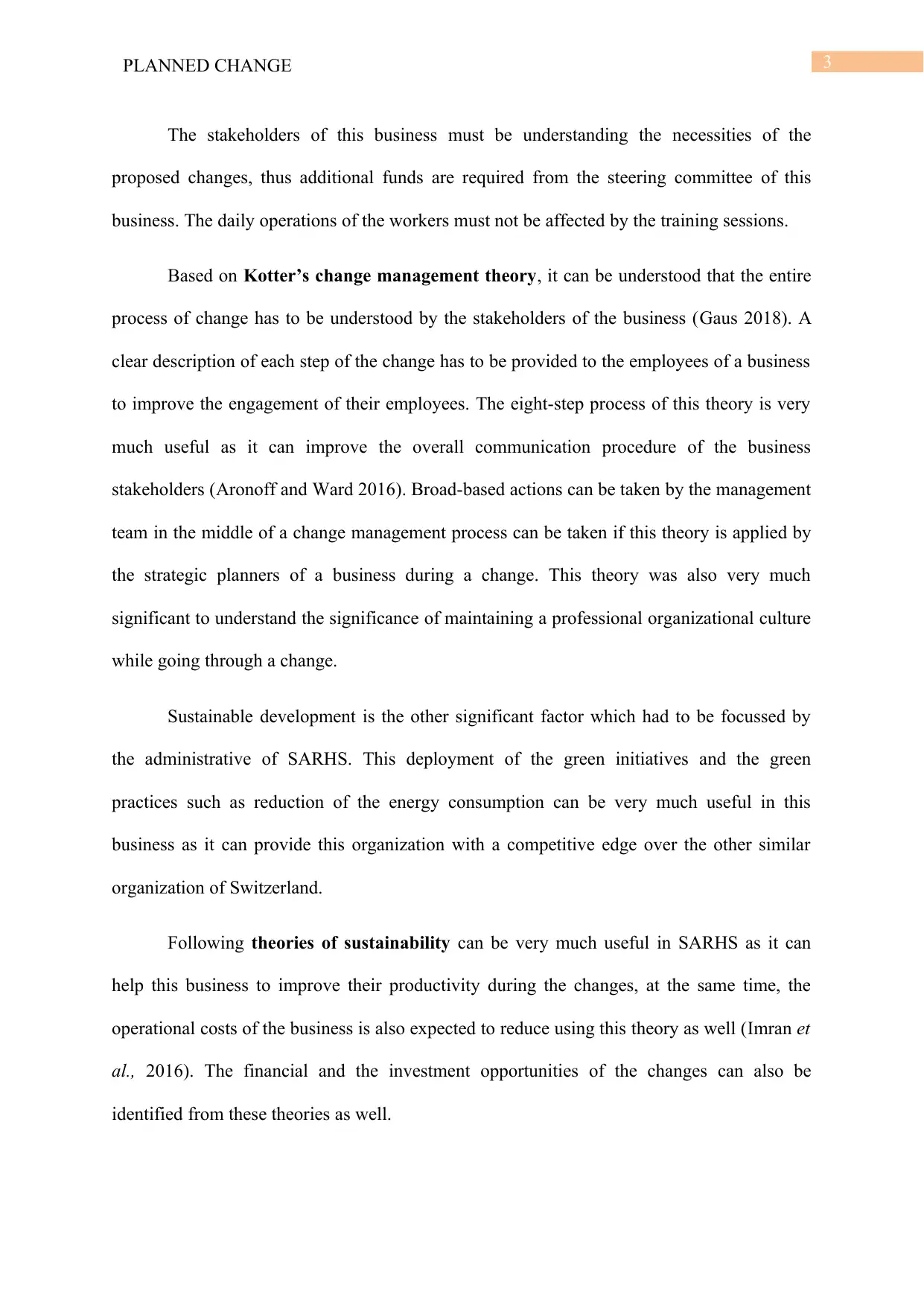
3PLANNED CHANGE
The stakeholders of this business must be understanding the necessities of the
proposed changes, thus additional funds are required from the steering committee of this
business. The daily operations of the workers must not be affected by the training sessions.
Based on Kotter’s change management theory, it can be understood that the entire
process of change has to be understood by the stakeholders of the business (Gaus 2018). A
clear description of each step of the change has to be provided to the employees of a business
to improve the engagement of their employees. The eight-step process of this theory is very
much useful as it can improve the overall communication procedure of the business
stakeholders (Aronoff and Ward 2016). Broad-based actions can be taken by the management
team in the middle of a change management process can be taken if this theory is applied by
the strategic planners of a business during a change. This theory was also very much
significant to understand the significance of maintaining a professional organizational culture
while going through a change.
Sustainable development is the other significant factor which had to be focussed by
the administrative of SARHS. This deployment of the green initiatives and the green
practices such as reduction of the energy consumption can be very much useful in this
business as it can provide this organization with a competitive edge over the other similar
organization of Switzerland.
Following theories of sustainability can be very much useful in SARHS as it can
help this business to improve their productivity during the changes, at the same time, the
operational costs of the business is also expected to reduce using this theory as well (Imran et
al., 2016). The financial and the investment opportunities of the changes can also be
identified from these theories as well.
The stakeholders of this business must be understanding the necessities of the
proposed changes, thus additional funds are required from the steering committee of this
business. The daily operations of the workers must not be affected by the training sessions.
Based on Kotter’s change management theory, it can be understood that the entire
process of change has to be understood by the stakeholders of the business (Gaus 2018). A
clear description of each step of the change has to be provided to the employees of a business
to improve the engagement of their employees. The eight-step process of this theory is very
much useful as it can improve the overall communication procedure of the business
stakeholders (Aronoff and Ward 2016). Broad-based actions can be taken by the management
team in the middle of a change management process can be taken if this theory is applied by
the strategic planners of a business during a change. This theory was also very much
significant to understand the significance of maintaining a professional organizational culture
while going through a change.
Sustainable development is the other significant factor which had to be focussed by
the administrative of SARHS. This deployment of the green initiatives and the green
practices such as reduction of the energy consumption can be very much useful in this
business as it can provide this organization with a competitive edge over the other similar
organization of Switzerland.
Following theories of sustainability can be very much useful in SARHS as it can
help this business to improve their productivity during the changes, at the same time, the
operational costs of the business is also expected to reduce using this theory as well (Imran et
al., 2016). The financial and the investment opportunities of the changes can also be
identified from these theories as well.
Paraphrase This Document
Need a fresh take? Get an instant paraphrase of this document with our AI Paraphraser
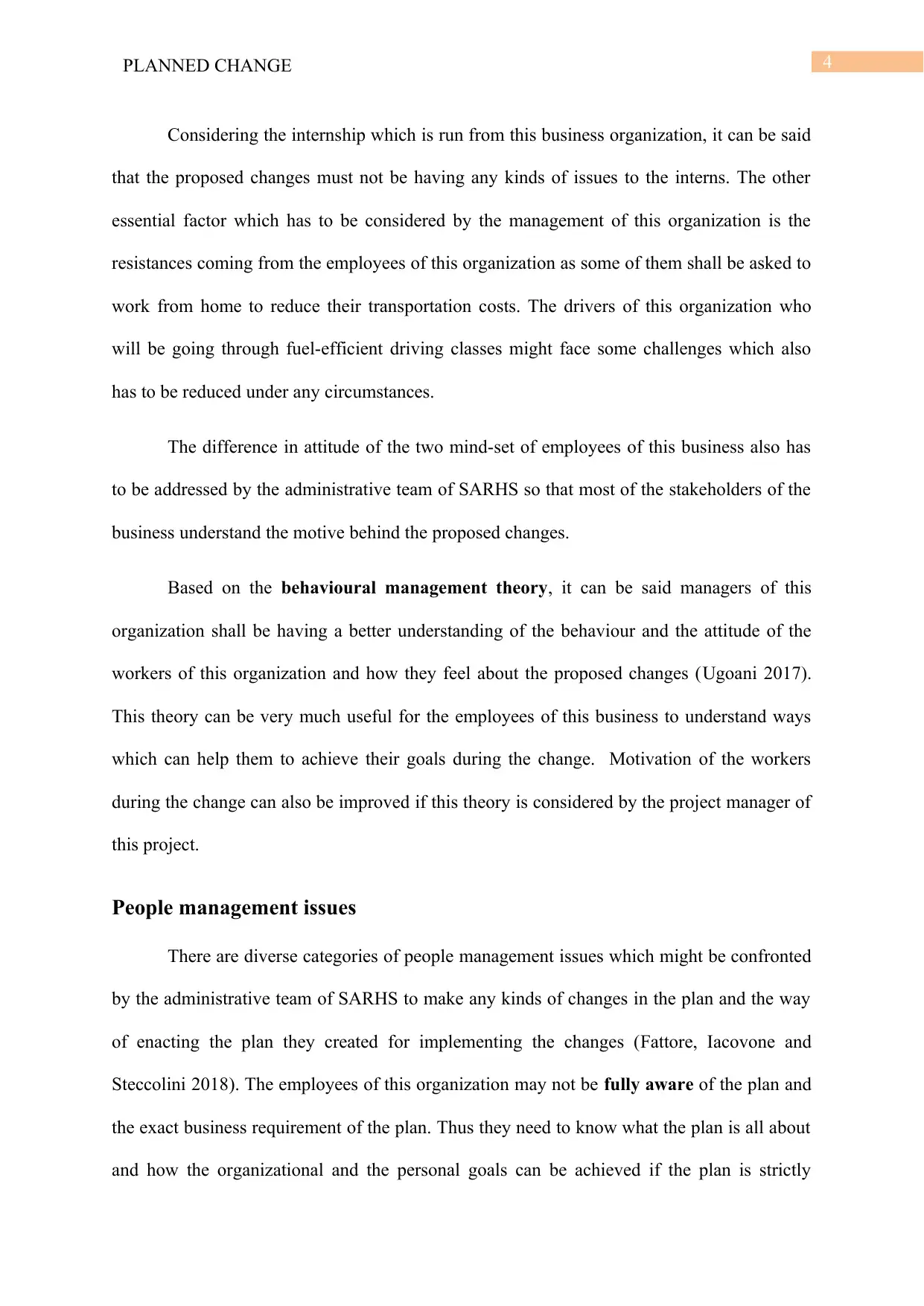
4PLANNED CHANGE
Considering the internship which is run from this business organization, it can be said
that the proposed changes must not be having any kinds of issues to the interns. The other
essential factor which has to be considered by the management of this organization is the
resistances coming from the employees of this organization as some of them shall be asked to
work from home to reduce their transportation costs. The drivers of this organization who
will be going through fuel-efficient driving classes might face some challenges which also
has to be reduced under any circumstances.
The difference in attitude of the two mind-set of employees of this business also has
to be addressed by the administrative team of SARHS so that most of the stakeholders of the
business understand the motive behind the proposed changes.
Based on the behavioural management theory, it can be said managers of this
organization shall be having a better understanding of the behaviour and the attitude of the
workers of this organization and how they feel about the proposed changes (Ugoani 2017).
This theory can be very much useful for the employees of this business to understand ways
which can help them to achieve their goals during the change. Motivation of the workers
during the change can also be improved if this theory is considered by the project manager of
this project.
People management issues
There are diverse categories of people management issues which might be confronted
by the administrative team of SARHS to make any kinds of changes in the plan and the way
of enacting the plan they created for implementing the changes (Fattore, Iacovone and
Steccolini 2018). The employees of this organization may not be fully aware of the plan and
the exact business requirement of the plan. Thus they need to know what the plan is all about
and how the organizational and the personal goals can be achieved if the plan is strictly
Considering the internship which is run from this business organization, it can be said
that the proposed changes must not be having any kinds of issues to the interns. The other
essential factor which has to be considered by the management of this organization is the
resistances coming from the employees of this organization as some of them shall be asked to
work from home to reduce their transportation costs. The drivers of this organization who
will be going through fuel-efficient driving classes might face some challenges which also
has to be reduced under any circumstances.
The difference in attitude of the two mind-set of employees of this business also has
to be addressed by the administrative team of SARHS so that most of the stakeholders of the
business understand the motive behind the proposed changes.
Based on the behavioural management theory, it can be said managers of this
organization shall be having a better understanding of the behaviour and the attitude of the
workers of this organization and how they feel about the proposed changes (Ugoani 2017).
This theory can be very much useful for the employees of this business to understand ways
which can help them to achieve their goals during the change. Motivation of the workers
during the change can also be improved if this theory is considered by the project manager of
this project.
People management issues
There are diverse categories of people management issues which might be confronted
by the administrative team of SARHS to make any kinds of changes in the plan and the way
of enacting the plan they created for implementing the changes (Fattore, Iacovone and
Steccolini 2018). The employees of this organization may not be fully aware of the plan and
the exact business requirement of the plan. Thus they need to know what the plan is all about
and how the organizational and the personal goals can be achieved if the plan is strictly
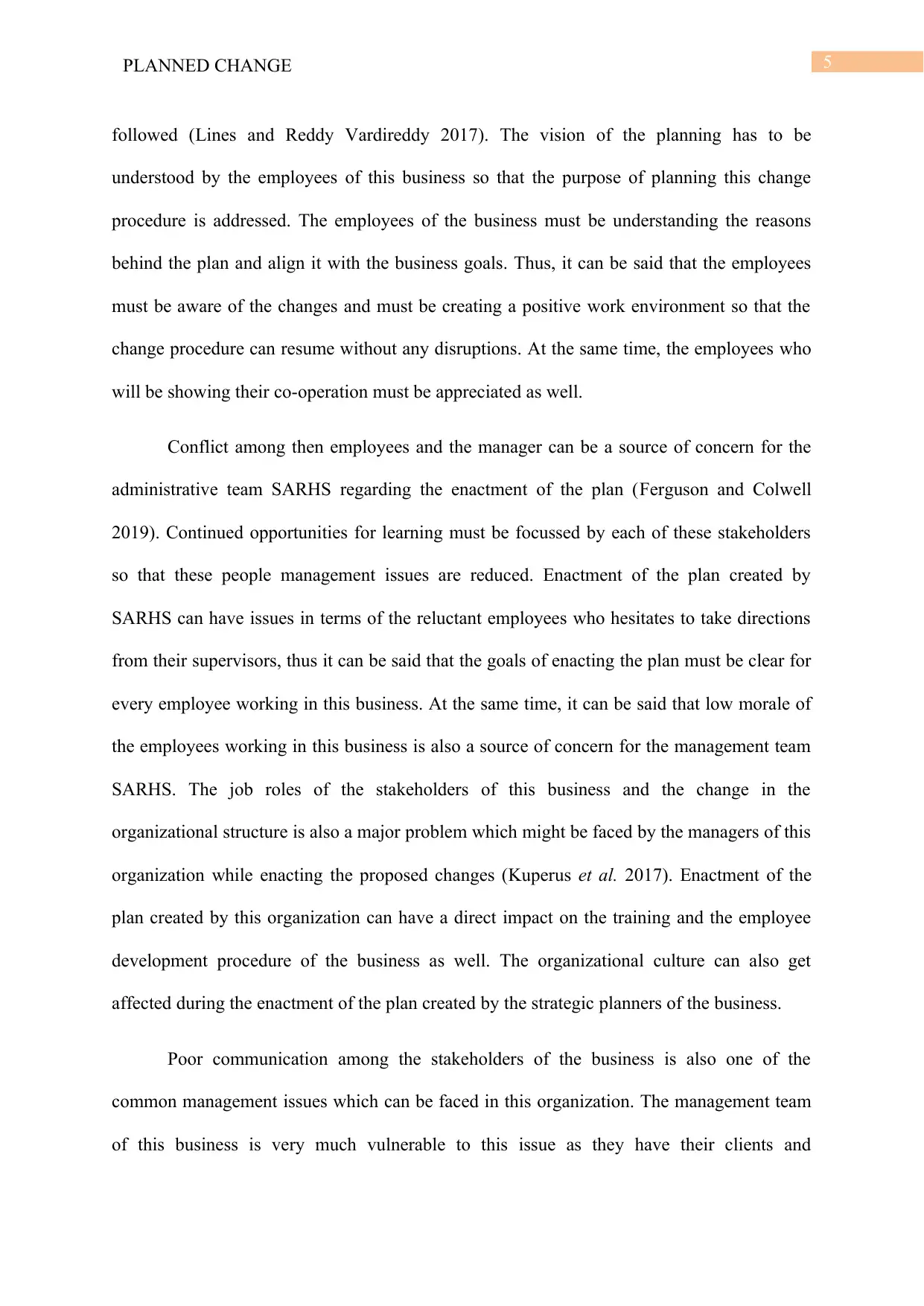
5PLANNED CHANGE
followed (Lines and Reddy Vardireddy 2017). The vision of the planning has to be
understood by the employees of this business so that the purpose of planning this change
procedure is addressed. The employees of the business must be understanding the reasons
behind the plan and align it with the business goals. Thus, it can be said that the employees
must be aware of the changes and must be creating a positive work environment so that the
change procedure can resume without any disruptions. At the same time, the employees who
will be showing their co-operation must be appreciated as well.
Conflict among then employees and the manager can be a source of concern for the
administrative team SARHS regarding the enactment of the plan (Ferguson and Colwell
2019). Continued opportunities for learning must be focussed by each of these stakeholders
so that these people management issues are reduced. Enactment of the plan created by
SARHS can have issues in terms of the reluctant employees who hesitates to take directions
from their supervisors, thus it can be said that the goals of enacting the plan must be clear for
every employee working in this business. At the same time, it can be said that low morale of
the employees working in this business is also a source of concern for the management team
SARHS. The job roles of the stakeholders of this business and the change in the
organizational structure is also a major problem which might be faced by the managers of this
organization while enacting the proposed changes (Kuperus et al. 2017). Enactment of the
plan created by this organization can have a direct impact on the training and the employee
development procedure of the business as well. The organizational culture can also get
affected during the enactment of the plan created by the strategic planners of the business.
Poor communication among the stakeholders of the business is also one of the
common management issues which can be faced in this organization. The management team
of this business is very much vulnerable to this issue as they have their clients and
followed (Lines and Reddy Vardireddy 2017). The vision of the planning has to be
understood by the employees of this business so that the purpose of planning this change
procedure is addressed. The employees of the business must be understanding the reasons
behind the plan and align it with the business goals. Thus, it can be said that the employees
must be aware of the changes and must be creating a positive work environment so that the
change procedure can resume without any disruptions. At the same time, the employees who
will be showing their co-operation must be appreciated as well.
Conflict among then employees and the manager can be a source of concern for the
administrative team SARHS regarding the enactment of the plan (Ferguson and Colwell
2019). Continued opportunities for learning must be focussed by each of these stakeholders
so that these people management issues are reduced. Enactment of the plan created by
SARHS can have issues in terms of the reluctant employees who hesitates to take directions
from their supervisors, thus it can be said that the goals of enacting the plan must be clear for
every employee working in this business. At the same time, it can be said that low morale of
the employees working in this business is also a source of concern for the management team
SARHS. The job roles of the stakeholders of this business and the change in the
organizational structure is also a major problem which might be faced by the managers of this
organization while enacting the proposed changes (Kuperus et al. 2017). Enactment of the
plan created by this organization can have a direct impact on the training and the employee
development procedure of the business as well. The organizational culture can also get
affected during the enactment of the plan created by the strategic planners of the business.
Poor communication among the stakeholders of the business is also one of the
common management issues which can be faced in this organization. The management team
of this business is very much vulnerable to this issue as they have their clients and
⊘ This is a preview!⊘
Do you want full access?
Subscribe today to unlock all pages.

Trusted by 1+ million students worldwide
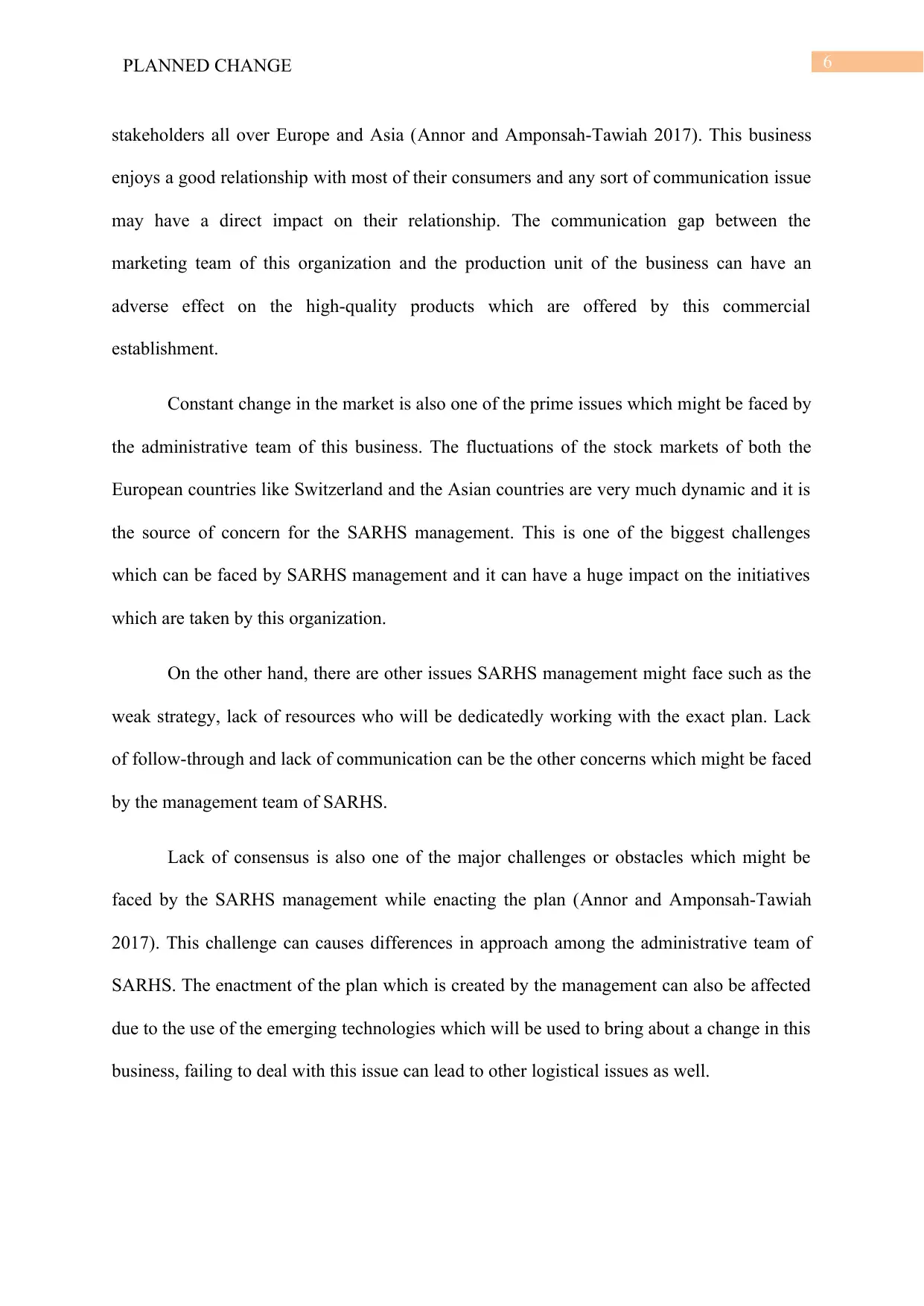
6PLANNED CHANGE
stakeholders all over Europe and Asia (Annor and Amponsah-Tawiah 2017). This business
enjoys a good relationship with most of their consumers and any sort of communication issue
may have a direct impact on their relationship. The communication gap between the
marketing team of this organization and the production unit of the business can have an
adverse effect on the high-quality products which are offered by this commercial
establishment.
Constant change in the market is also one of the prime issues which might be faced by
the administrative team of this business. The fluctuations of the stock markets of both the
European countries like Switzerland and the Asian countries are very much dynamic and it is
the source of concern for the SARHS management. This is one of the biggest challenges
which can be faced by SARHS management and it can have a huge impact on the initiatives
which are taken by this organization.
On the other hand, there are other issues SARHS management might face such as the
weak strategy, lack of resources who will be dedicatedly working with the exact plan. Lack
of follow-through and lack of communication can be the other concerns which might be faced
by the management team of SARHS.
Lack of consensus is also one of the major challenges or obstacles which might be
faced by the SARHS management while enacting the plan (Annor and Amponsah-Tawiah
2017). This challenge can causes differences in approach among the administrative team of
SARHS. The enactment of the plan which is created by the management can also be affected
due to the use of the emerging technologies which will be used to bring about a change in this
business, failing to deal with this issue can lead to other logistical issues as well.
stakeholders all over Europe and Asia (Annor and Amponsah-Tawiah 2017). This business
enjoys a good relationship with most of their consumers and any sort of communication issue
may have a direct impact on their relationship. The communication gap between the
marketing team of this organization and the production unit of the business can have an
adverse effect on the high-quality products which are offered by this commercial
establishment.
Constant change in the market is also one of the prime issues which might be faced by
the administrative team of this business. The fluctuations of the stock markets of both the
European countries like Switzerland and the Asian countries are very much dynamic and it is
the source of concern for the SARHS management. This is one of the biggest challenges
which can be faced by SARHS management and it can have a huge impact on the initiatives
which are taken by this organization.
On the other hand, there are other issues SARHS management might face such as the
weak strategy, lack of resources who will be dedicatedly working with the exact plan. Lack
of follow-through and lack of communication can be the other concerns which might be faced
by the management team of SARHS.
Lack of consensus is also one of the major challenges or obstacles which might be
faced by the SARHS management while enacting the plan (Annor and Amponsah-Tawiah
2017). This challenge can causes differences in approach among the administrative team of
SARHS. The enactment of the plan which is created by the management can also be affected
due to the use of the emerging technologies which will be used to bring about a change in this
business, failing to deal with this issue can lead to other logistical issues as well.
Paraphrase This Document
Need a fresh take? Get an instant paraphrase of this document with our AI Paraphraser

7PLANNED CHANGE
Recommendations as to how to proceed with this project
Mid-level managers must be there for the employees of this business as they can make
the workers understand the significance of plan and the business operations which are already
in process (Holland 2016). The role of the error managers is very much significant to deal
with the constant changes in the stock market. The rate of the services offered by this
organization has to get revised based on the local market conditions and the availability of
resources available in the local market (Karhula et al. 2017). In order to address the threat
coming from a lack of consensus, regular board meetings must be conducted among the
stakeholders of this business. The employees of this business must be updated regularly about
the plans and the progress of the project.
The conduction of this project shall be having numerous challenges, however, the role
of the strategic planner of this project shall be very much useful regarding the successful
completion of this project. It can also be said that the role of the executive team of this
business is also very much significant for releasing the funds required in this project. This
change management procedure must be considering all the factors which shall play a leading
role in this project such as the vision of the organizational leaders of the project, employee
engagement and participation, and communication among the stakeholders of the project.
It can be recommended that all the key elements of successful change management
such as the leadership abilities of the project manager, clear ad motivating goals and
objectives, an effective communication plan for each level of employees, and successful
change initiatives can play a huge role to address the obstacles of this project.
Conferring to Chang et al. (2017), numerous factors are there which has to be
considered to bring out a change in a contemporary business environment such as
determining the role of the stakeholder involve in the change management process. The
Recommendations as to how to proceed with this project
Mid-level managers must be there for the employees of this business as they can make
the workers understand the significance of plan and the business operations which are already
in process (Holland 2016). The role of the error managers is very much significant to deal
with the constant changes in the stock market. The rate of the services offered by this
organization has to get revised based on the local market conditions and the availability of
resources available in the local market (Karhula et al. 2017). In order to address the threat
coming from a lack of consensus, regular board meetings must be conducted among the
stakeholders of this business. The employees of this business must be updated regularly about
the plans and the progress of the project.
The conduction of this project shall be having numerous challenges, however, the role
of the strategic planner of this project shall be very much useful regarding the successful
completion of this project. It can also be said that the role of the executive team of this
business is also very much significant for releasing the funds required in this project. This
change management procedure must be considering all the factors which shall play a leading
role in this project such as the vision of the organizational leaders of the project, employee
engagement and participation, and communication among the stakeholders of the project.
It can be recommended that all the key elements of successful change management
such as the leadership abilities of the project manager, clear ad motivating goals and
objectives, an effective communication plan for each level of employees, and successful
change initiatives can play a huge role to address the obstacles of this project.
Conferring to Chang et al. (2017), numerous factors are there which has to be
considered to bring out a change in a contemporary business environment such as
determining the role of the stakeholder involve in the change management process. The
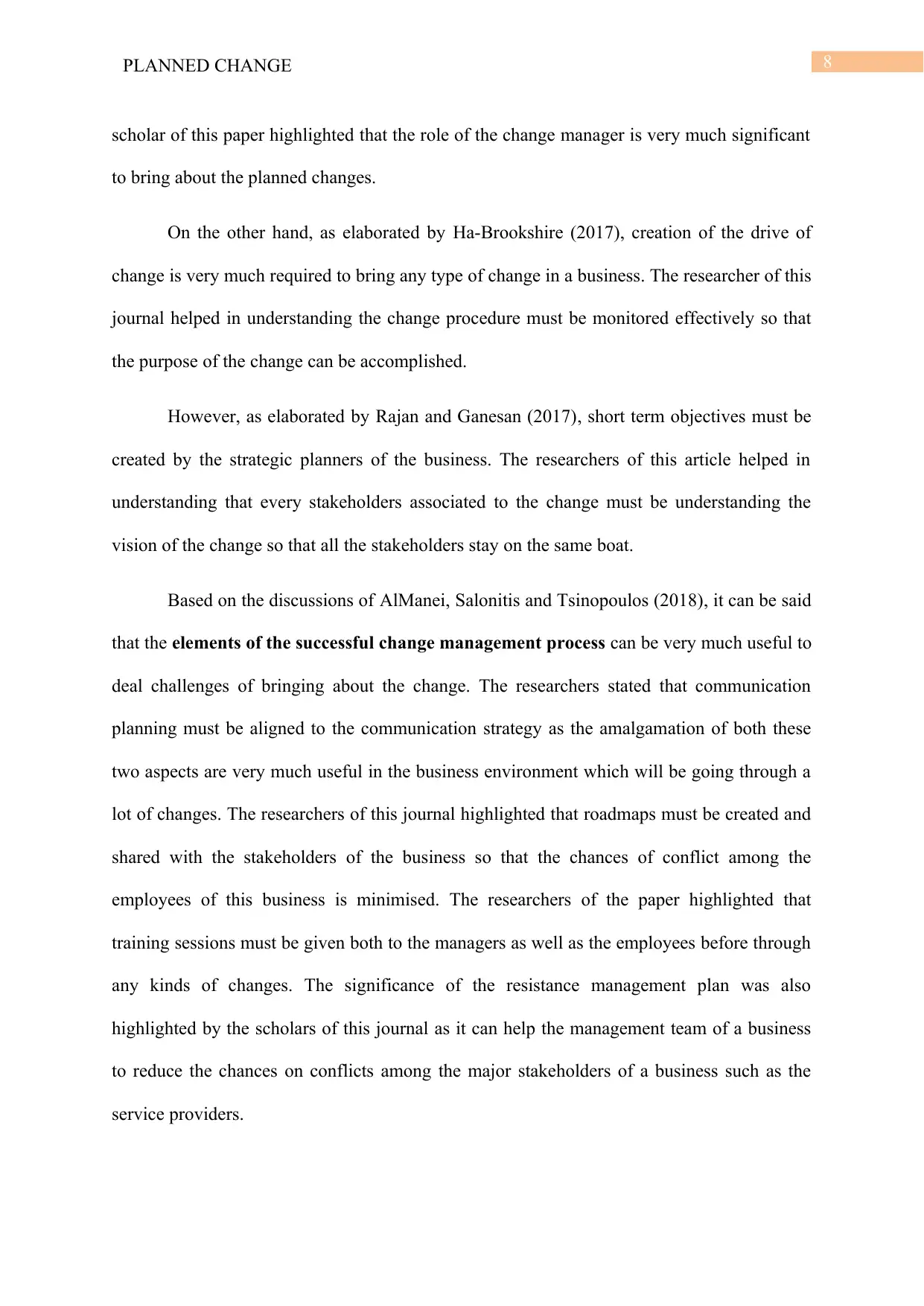
8PLANNED CHANGE
scholar of this paper highlighted that the role of the change manager is very much significant
to bring about the planned changes.
On the other hand, as elaborated by Ha-Brookshire (2017), creation of the drive of
change is very much required to bring any type of change in a business. The researcher of this
journal helped in understanding the change procedure must be monitored effectively so that
the purpose of the change can be accomplished.
However, as elaborated by Rajan and Ganesan (2017), short term objectives must be
created by the strategic planners of the business. The researchers of this article helped in
understanding that every stakeholders associated to the change must be understanding the
vision of the change so that all the stakeholders stay on the same boat.
Based on the discussions of AlManei, Salonitis and Tsinopoulos (2018), it can be said
that the elements of the successful change management process can be very much useful to
deal challenges of bringing about the change. The researchers stated that communication
planning must be aligned to the communication strategy as the amalgamation of both these
two aspects are very much useful in the business environment which will be going through a
lot of changes. The researchers of this journal highlighted that roadmaps must be created and
shared with the stakeholders of the business so that the chances of conflict among the
employees of this business is minimised. The researchers of the paper highlighted that
training sessions must be given both to the managers as well as the employees before through
any kinds of changes. The significance of the resistance management plan was also
highlighted by the scholars of this journal as it can help the management team of a business
to reduce the chances on conflicts among the major stakeholders of a business such as the
service providers.
scholar of this paper highlighted that the role of the change manager is very much significant
to bring about the planned changes.
On the other hand, as elaborated by Ha-Brookshire (2017), creation of the drive of
change is very much required to bring any type of change in a business. The researcher of this
journal helped in understanding the change procedure must be monitored effectively so that
the purpose of the change can be accomplished.
However, as elaborated by Rajan and Ganesan (2017), short term objectives must be
created by the strategic planners of the business. The researchers of this article helped in
understanding that every stakeholders associated to the change must be understanding the
vision of the change so that all the stakeholders stay on the same boat.
Based on the discussions of AlManei, Salonitis and Tsinopoulos (2018), it can be said
that the elements of the successful change management process can be very much useful to
deal challenges of bringing about the change. The researchers stated that communication
planning must be aligned to the communication strategy as the amalgamation of both these
two aspects are very much useful in the business environment which will be going through a
lot of changes. The researchers of this journal highlighted that roadmaps must be created and
shared with the stakeholders of the business so that the chances of conflict among the
employees of this business is minimised. The researchers of the paper highlighted that
training sessions must be given both to the managers as well as the employees before through
any kinds of changes. The significance of the resistance management plan was also
highlighted by the scholars of this journal as it can help the management team of a business
to reduce the chances on conflicts among the major stakeholders of a business such as the
service providers.
⊘ This is a preview!⊘
Do you want full access?
Subscribe today to unlock all pages.

Trusted by 1+ million students worldwide
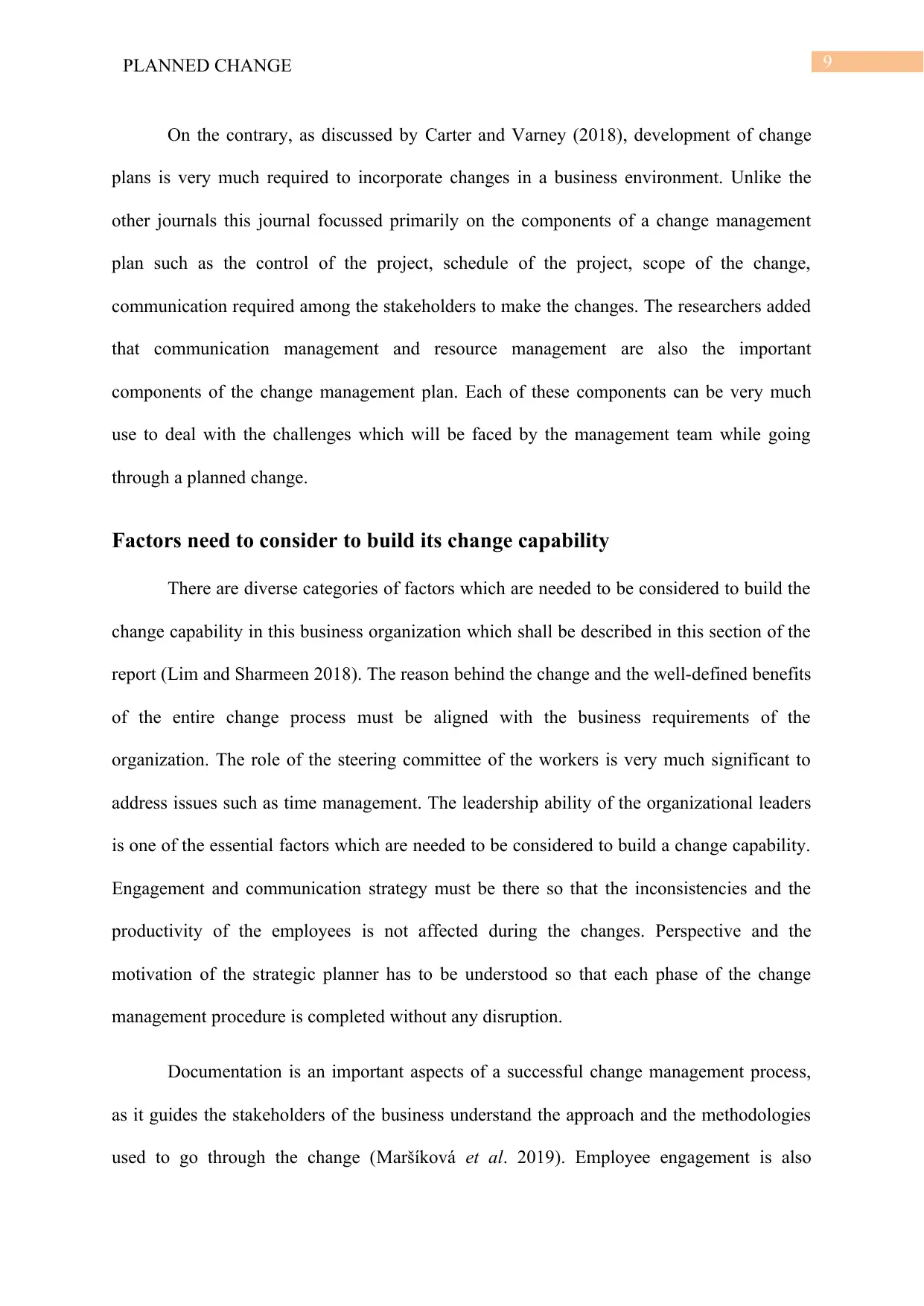
9PLANNED CHANGE
On the contrary, as discussed by Carter and Varney (2018), development of change
plans is very much required to incorporate changes in a business environment. Unlike the
other journals this journal focussed primarily on the components of a change management
plan such as the control of the project, schedule of the project, scope of the change,
communication required among the stakeholders to make the changes. The researchers added
that communication management and resource management are also the important
components of the change management plan. Each of these components can be very much
use to deal with the challenges which will be faced by the management team while going
through a planned change.
Factors need to consider to build its change capability
There are diverse categories of factors which are needed to be considered to build the
change capability in this business organization which shall be described in this section of the
report (Lim and Sharmeen 2018). The reason behind the change and the well-defined benefits
of the entire change process must be aligned with the business requirements of the
organization. The role of the steering committee of the workers is very much significant to
address issues such as time management. The leadership ability of the organizational leaders
is one of the essential factors which are needed to be considered to build a change capability.
Engagement and communication strategy must be there so that the inconsistencies and the
productivity of the employees is not affected during the changes. Perspective and the
motivation of the strategic planner has to be understood so that each phase of the change
management procedure is completed without any disruption.
Documentation is an important aspects of a successful change management process,
as it guides the stakeholders of the business understand the approach and the methodologies
used to go through the change (Maršíková et al. 2019). Employee engagement is also
On the contrary, as discussed by Carter and Varney (2018), development of change
plans is very much required to incorporate changes in a business environment. Unlike the
other journals this journal focussed primarily on the components of a change management
plan such as the control of the project, schedule of the project, scope of the change,
communication required among the stakeholders to make the changes. The researchers added
that communication management and resource management are also the important
components of the change management plan. Each of these components can be very much
use to deal with the challenges which will be faced by the management team while going
through a planned change.
Factors need to consider to build its change capability
There are diverse categories of factors which are needed to be considered to build the
change capability in this business organization which shall be described in this section of the
report (Lim and Sharmeen 2018). The reason behind the change and the well-defined benefits
of the entire change process must be aligned with the business requirements of the
organization. The role of the steering committee of the workers is very much significant to
address issues such as time management. The leadership ability of the organizational leaders
is one of the essential factors which are needed to be considered to build a change capability.
Engagement and communication strategy must be there so that the inconsistencies and the
productivity of the employees is not affected during the changes. Perspective and the
motivation of the strategic planner has to be understood so that each phase of the change
management procedure is completed without any disruption.
Documentation is an important aspects of a successful change management process,
as it guides the stakeholders of the business understand the approach and the methodologies
used to go through the change (Maršíková et al. 2019). Employee engagement is also
Paraphrase This Document
Need a fresh take? Get an instant paraphrase of this document with our AI Paraphraser
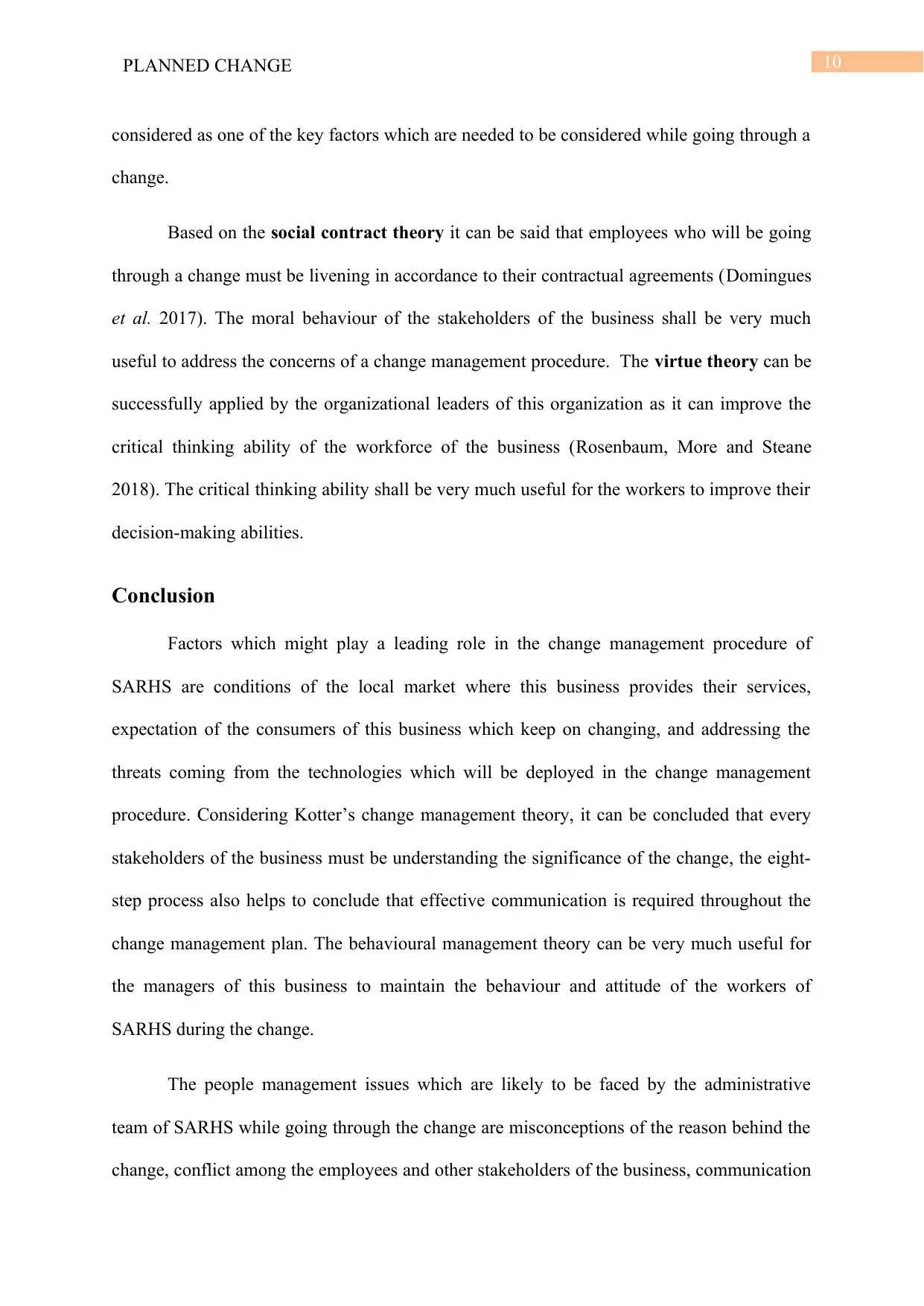
10PLANNED CHANGE
considered as one of the key factors which are needed to be considered while going through a
change.
Based on the social contract theory it can be said that employees who will be going
through a change must be livening in accordance to their contractual agreements (Domingues
et al. 2017). The moral behaviour of the stakeholders of the business shall be very much
useful to address the concerns of a change management procedure. The virtue theory can be
successfully applied by the organizational leaders of this organization as it can improve the
critical thinking ability of the workforce of the business (Rosenbaum, More and Steane
2018). The critical thinking ability shall be very much useful for the workers to improve their
decision-making abilities.
Conclusion
Factors which might play a leading role in the change management procedure of
SARHS are conditions of the local market where this business provides their services,
expectation of the consumers of this business which keep on changing, and addressing the
threats coming from the technologies which will be deployed in the change management
procedure. Considering Kotter’s change management theory, it can be concluded that every
stakeholders of the business must be understanding the significance of the change, the eight-
step process also helps to conclude that effective communication is required throughout the
change management plan. The behavioural management theory can be very much useful for
the managers of this business to maintain the behaviour and attitude of the workers of
SARHS during the change.
The people management issues which are likely to be faced by the administrative
team of SARHS while going through the change are misconceptions of the reason behind the
change, conflict among the employees and other stakeholders of the business, communication
considered as one of the key factors which are needed to be considered while going through a
change.
Based on the social contract theory it can be said that employees who will be going
through a change must be livening in accordance to their contractual agreements (Domingues
et al. 2017). The moral behaviour of the stakeholders of the business shall be very much
useful to address the concerns of a change management procedure. The virtue theory can be
successfully applied by the organizational leaders of this organization as it can improve the
critical thinking ability of the workforce of the business (Rosenbaum, More and Steane
2018). The critical thinking ability shall be very much useful for the workers to improve their
decision-making abilities.
Conclusion
Factors which might play a leading role in the change management procedure of
SARHS are conditions of the local market where this business provides their services,
expectation of the consumers of this business which keep on changing, and addressing the
threats coming from the technologies which will be deployed in the change management
procedure. Considering Kotter’s change management theory, it can be concluded that every
stakeholders of the business must be understanding the significance of the change, the eight-
step process also helps to conclude that effective communication is required throughout the
change management plan. The behavioural management theory can be very much useful for
the managers of this business to maintain the behaviour and attitude of the workers of
SARHS during the change.
The people management issues which are likely to be faced by the administrative
team of SARHS while going through the change are misconceptions of the reason behind the
change, conflict among the employees and other stakeholders of the business, communication
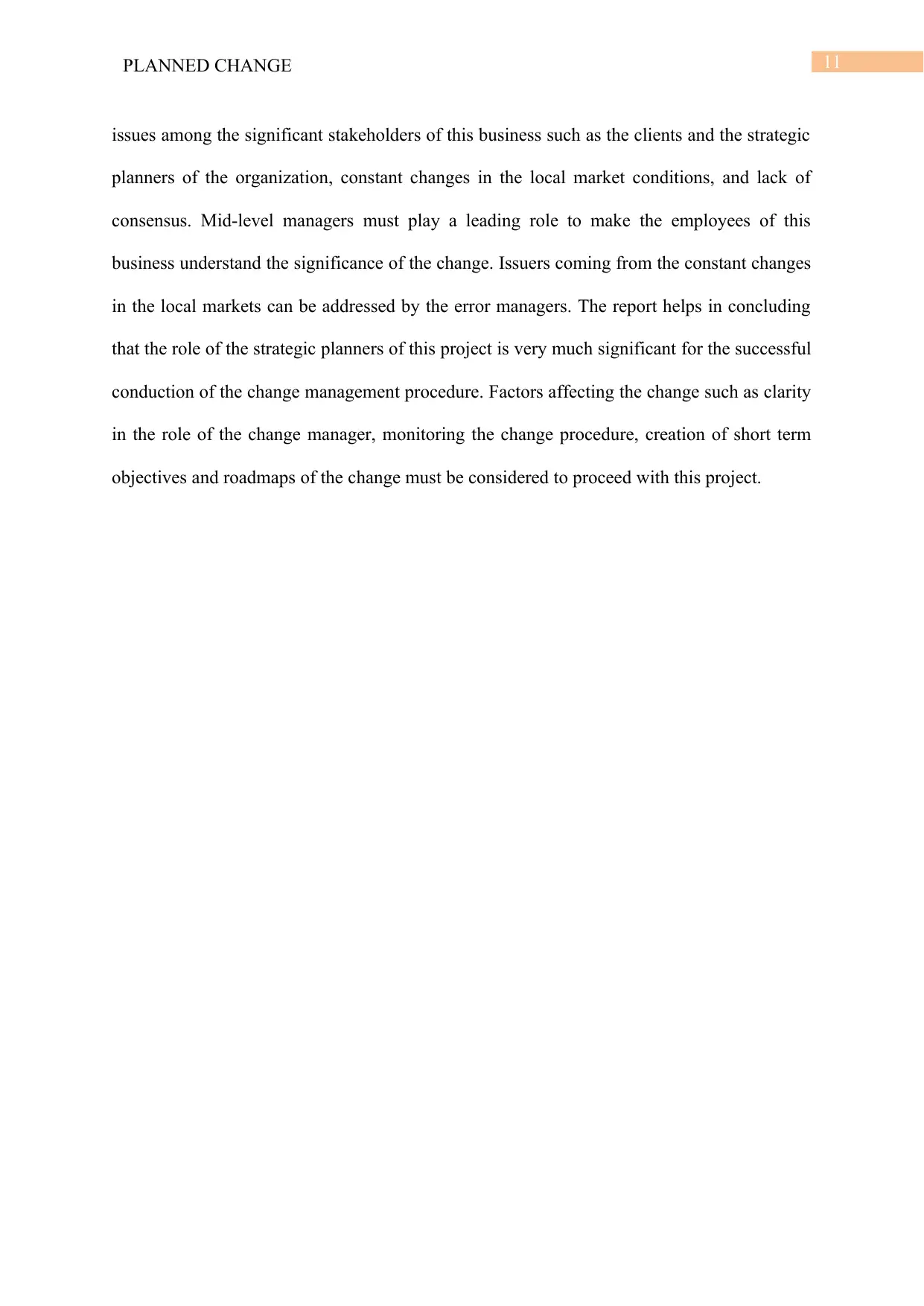
11PLANNED CHANGE
issues among the significant stakeholders of this business such as the clients and the strategic
planners of the organization, constant changes in the local market conditions, and lack of
consensus. Mid-level managers must play a leading role to make the employees of this
business understand the significance of the change. Issuers coming from the constant changes
in the local markets can be addressed by the error managers. The report helps in concluding
that the role of the strategic planners of this project is very much significant for the successful
conduction of the change management procedure. Factors affecting the change such as clarity
in the role of the change manager, monitoring the change procedure, creation of short term
objectives and roadmaps of the change must be considered to proceed with this project.
issues among the significant stakeholders of this business such as the clients and the strategic
planners of the organization, constant changes in the local market conditions, and lack of
consensus. Mid-level managers must play a leading role to make the employees of this
business understand the significance of the change. Issuers coming from the constant changes
in the local markets can be addressed by the error managers. The report helps in concluding
that the role of the strategic planners of this project is very much significant for the successful
conduction of the change management procedure. Factors affecting the change such as clarity
in the role of the change manager, monitoring the change procedure, creation of short term
objectives and roadmaps of the change must be considered to proceed with this project.
⊘ This is a preview!⊘
Do you want full access?
Subscribe today to unlock all pages.

Trusted by 1+ million students worldwide
1 out of 16
Related Documents
Your All-in-One AI-Powered Toolkit for Academic Success.
+13062052269
info@desklib.com
Available 24*7 on WhatsApp / Email
![[object Object]](/_next/static/media/star-bottom.7253800d.svg)
Unlock your academic potential
Copyright © 2020–2025 A2Z Services. All Rights Reserved. Developed and managed by ZUCOL.





